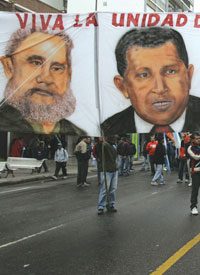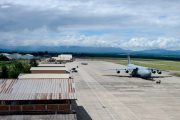
Many Cuban refugees risked everything to escape the murderous regime of Fidel Castro. Oftentimes they made treacherous voyages aboard rickety rafts, hoping only to reach the free shores of Florida with their lives. Many died along the way. But communist rule was vicious and unforgiving.
So when the Berlin Wall came down and the Iron Curtain was raised, people around the world breathed a sigh of relief. It was generally accepted that it would only be a matter of time before communism fell everywhere, including Latin America. But instead, something else happened south of the border — it morphed and continued its march through the region with unprecedented ease.
Now, there is a new wave of people fleeing Latin American tyranny and arriving in Miami. Jorge Bastidas, 57, was a successful small business owner on the touristy Venezuelan island of Margarita when avowed socialist Hugo Chavez seized the reins of power in 1998. A lot of Venezuelans liked Chavez in the beginning, Bastidas said, “but once in power, he took off the mask and revealed a monster.” The effects of his policies soon hit home.
“When he took over, the economy of our island was devastated,” Bastidas told The New American. “It went down and down and down until whole shopping malls, hotels, restaurants — all kinds of businesses really — were forced to shut down. And we got caught up in this too — it was horrible.”
In addition to the economy crumbling, crime and insecurity exploded, as persecution of the political opposition began. “I was a member of an organization that was opposed to Chavez,” explained Bastidas, also a father of two children. “And so, it happened: Any person who did not support him became his enemy. We were persecuted to the point where it became intolerable, and so when the opportunity arose, we had to leave.”
Bastidas has not returned home since that fateful day, but if Chavez is ever ousted, he would like to. Unfortunately, though, he isn’t hopeful. “That man will never — never — leave power through votes, of this I’m certain. He cheats!”
Not everybody was as lucky. Many middle-class business owners have had their businesses and property seized and have nowhere to run. And as Chavez grows increasingly authoritarian — backed up by friendly neighboring regimes, a seemingly endless supply of “petrodollars,” and shiploads of sophisticated Russian weaponry — Venezuela has unquestionably descended into full-blown totalitarianism.
The socialist leader routinely threatens to jail political opponents, even arresting a sitting Governor for allegedly conspiring against him. The former Defense Minister was also imprisoned after publicly opposing Chavez’ unconstitutional power grab to remain in office indefinitely.
The regime shut down six television stations just this year for failing to broadcast all of Chavez’ speeches. It has closed dozens of radio stations that were not sufficiently supportive. Now, Chavez wants to jail broadcasters who don’t abide by his “regulations.”
Leftists Advance: Nation by Nation
The Venezuelan people are not the only ones suffering under this resurgence of fanatical left-wing leaders.
The BBC reported in 2005 that 75 percent of South Americans were governed by leftist rulers, all of whom had risen to power in the preceding six years. And the trend has only accelerated since then, with some analysts using the term “Pink Tide” to describe the phenomenon that has enveloped Latin America.
Bolivia: With strong backing from Chavez, former coca farmer Evo Morales of the Movement for Socialism assumed power in 2006. His party now controls about two-thirds of both Parliamentary houses and has already “redistributed” over 60,000 acres of land. Foreign capital has nearly vanished. But incredibly, the government promises to intensify its efforts.
Ecuador: Radical leftist Rafael Correa, another proponent of Chavez’ “21st Century Socialism,” became President in 2007. “Socialism will continue,” he boldly announced after being elected, ending his victory speech with communist mass-murderer Ernesto Che Guevara’s famous words “Hasta la victoria siempre” (until victory always/forever).
Brazil: Latin America’s largest nation has been under the thumb of a charismatic radical left-wing President since 2003 — though he does a better job of concealing his true intentions than other rulers in the region. A former labor leader who helped found the Workers’ Party, Luiz Inacio Lula da Silva has poured vast sums into wealth redistribution and various “anti-poverty” schemes. Though widely seen and presented as a “moderate,” he is far from it. In conjunction with communist despot Fidel Castro, “Lula,” as he is affectionately known, spawned a powerful socialist cabal that united leftist terrorists, social movements, and political parties in an astoundingly successful effort to conquer Latin America for the Left.
Nicaragua: Revolutionary Marxist and Sandinista Daniel Ortega re-assumed leadership in 2007, despite a long record of violent rule and accusations by his stepdaughter of systematic sexual abuse (he was never prosecuted owing to governmental immunity and the statute of limitations). In a bid to extend his power, Ortega’s first act in 2010 unconstitutionally extended the terms of corrupt but supportive judicial officials under the guise of “stability.”
Other nations that have come under control of leftist leaders in the last dec-ade include Uruguay, Chile, Argentina, Paraguay, El Salvador, the Dominican Republic and other Caribbean nations, and more. Many of the rulers came to power in questionable elections, with accusations of fraud running rampant. And in the few nations that have not already fallen to extremist left-wing governments, leftist forces often represent the main opposition parties. Examples of this include Peru, Colombia, and Costa Rica.
Supranational Integration
In addition to the proliferation of left-wing regimes, a variety of new supranational governments are emerging that threaten to centralize the left-wing totalitarianism and impose it on the few remaining holdouts.
One of the most dangerous transnational leftist integration schemes is the Bolivarian Alliance for the Peoples of Our Americas (ALBA), which includes Venezuela, Cuba, Bolivia, Ecuador, Nicaragua, Honduras, Antigua and Barbuda, Dominica, and Saint Vincent. The regional union is held together by disdain for the United States, capitalism, and liberty in general. It has already begun using a new transnational currency known as the SUCRE in commercial exchanges through the ALBA bank, and further “integration” is planned.
A broader regional government known as the Union of South American Nations includes every nation on the continent (except French Guiana, which is part of France). The “Bank of the South,” or BancoSur, is headquartered in Caracas, Venezuela, while the “South American Parliament” will likely be located in Bolivia. Currently led by socialist Ecuadorian President Correa, the scheme includes a military alliance called the South American Defense Council, a developing “common market,” and even plans to introduce a common currency. The integration process, modeled on the European Union, is expected to be completed in less than a decade.
Driving Force
Socialism’s present stature in the southern latitudes shouldn’t have been altogether unexpected, as the poor and middle classes in those countries revolted against false promises made by power-hungry “rightist” politicians and governments that sold the people on a type of corrupt capitalism peddled as free-market capitalism. While purporting to support freedom and free markets, these leaders often engage in a type of crony capitalism instead of true liberalization-oriented reforms.
In nation after nation that was supposedly turning toward capitalism, the state provided absurd benefits to politically connected businesses or elites at the expense of the people (like selling state-owned enterprises or assets at fire-sale prices to the ruling elite, who then improperly reap massive profits and continue to run inefficient monopolies).
With promises of prosperity, leftist regimes have been able to dupe the peoples into voluntarily surrendering their freedom, property, and any legitimate chance at future prosperity.
But this phenomenon alone could not possibly account for the firm grip that statists now hold over the reins of power in Latin America. Other factors figure in.
According to acclaimed Brazilian writer and philosopher Professor Olavo de Carvalho, over a dozen current governments in Latin America are connected through a shadowy, powerful, and little-known organization called the Foro de São Paulo (São Paulo Forum — FSP). The name refers to the Brazilian city where it was founded in 1990 by Castro, the Sandinistas, and Lula (the supposedly “moderate” president of Brazil). It is essentially a network comprised of over 100 leftist political parties, various social movements, and several guerrilla terrorist organizations such as the Fuerzas Armadas Revolucionarias de Colombia (FARC) and the Chilean Movimiento de la Izquierda Revolucionaria (MIR), among others. In recent years, bad publicity has forced the FSP to discourage leftist terrorist groups from sending official representatives to meetings. But according to experts and various reports obtained by The New American, this is merely a public-relations gimmick.
President Lula, who led the FSP for many years, defended the group and its collaboration with the FARC and other terrorist groups, saying that “18 years ago, in almost every South American country, there were political currents which argued that the only possible way to achieve power was violent struggle,” the AFP reported in a 2008 article. “In 1990, we created the São Paulo Forum, where we invited the entire Latin American Left to participate.”
Carvalho told The New American that the FSP “is the strategic command of the communist and pro-communist movement in the continent.” According to the group’s founding declaration, the mission is to, among other objectives, “renew leftist and socialist thought” and “to reaffirm its emancipating character.” Eventually its aims grew to include Latin American “integration” as well. And this is exactly the trend that has taken hold in the region.
Attempts to contact a spokesman for the FSP were unsuccessful. But despite the claims of its defenders, critics argue that the FSP is much more sinister than simply a “democratic” leftist vehicle.
But how did this secretive group become so powerful? “The Forum would never have accumulated so much power if its activities had been denounced from the outset, but during 16 years, big media and the establishment, in Latin America and in the U.S., refused to touch upon the subject, handing to the strategists of the communist revolution the protection of silence,” said Carvalho, possibly the most important individual involved in exposing the FSP.
Another factor is the support of powerful converging interests that include everything from governments and monopolistic businesses to drug traffickers and criminal organizations. “Legal parties cover up the activities of criminal groups, and these provide undercover financial resources to legal parties,” explained Carvalho.
Another crucial factor in the Latin American leftist resurgence is the assistance of former Soviet officials and other international connections, according to Toby Westerman, editor of International News Analysis and author of Lies, Terror and the Rise of the Neo-Communist Empire — Origins and Direction.
Westerman told The New American that a worldwide alliance including Communist China, Islamic fundamentalism, Iran, leftist Latin American rulers and guerrillas, and other forces were all collaborating in a war against the United States, united by their “anti-human, anti-God” ideology. “[The Russians] are running the same game, just slightly different — it’s more of a franchise operation than a central corporate operation, if you will. But if you take Russia out of it, the whole thing collapses.”
Indeed, the Russians have been supplying advanced weaponry to regimes like Chavez’. Russian National Security Council Chief Nikolai Patrushev actually attended the most recent ALBA summit last year. And China and Iran have both jumped on the bandwagon as well, cooperating with a variety of unsavory Latin American governments in myriad sectors and projects.
“We are creating a new world, a balanced world. A new world order, a multipolar world,” Chavez told reporters during a visit to Communist China, one of many. His “new world order” includes China, Iran, Japan, and a significantly weakened United States, he explained.
The Latin American leftists and the FSP have also received support from more “mainstream” Western European groups as well. The “European Left” (EL), a group that describes itself as an alliance of “left socialist, communist, and red-green parties in the European Union,” met in 2009 with representatives of the FSP and entered into a number of agreements for mutual assistance. To that end, the groups also developed “a linking mechanism, efficient and stable, between the [FSP] Secretariat, its regional secretaries, and the Executive Board of the EL,” according to a joint statement released by the EL.
So aside from any genuine discontent with false leaders on the so-called Right and the false image they have attached to free markets, there is a complex, interlocking network working in unison to advance what is essentially a new socialist revolution in Latin America. Hiding in the shadows, this network has had remarkable success in achieving its goals. And though the role of the U.S. government is hotly debated, U.S. policies are certainly not helping matters.
U.S. Involvement
Nearly every expert interviewed by The New American for this story had a different take on how the United States factors into the leftist resurgence. One view is that the U.S. government is secretly waging war against the leftist advances — at least the “21st Century Socialism” faction. “Bolivia and Ecuador, and more generally the region’s burgeoning social movements and Left political forces, are as much targets of this counteroffensive as Venezuela,” said William Robinson of the Latin American and Iberian Studies Program at the University of California. He claims the U.S. government is using a sophisticated combination of “military threats and hostilities with psychological operations, disinformation campaigns, black propaganda, economic sabotage, diplomatic pressures and the mobilization of political opposition forces inside the country” with the aim of provoking Chavez and other regimes into a “crackdown that transforms the democratic socialist process into an authoritarian one.”
But is the “Yankee empire” really waging a covert battle against the forces of communism and socialism in Latin America? Probably not, according to most analysts. One expert dismissed the notion as “nonsense.” If anything, the U.S. government has remained largely indifferent, he said. Others argue that the United States has, in fact, aided the revolution.
While the U.S. government has traditionally been perceived as opposed to leftist regimes in Latin America, the Obama administration took a different stance in Honduras, openly siding with Chavez, Castro, and the FARC in demanding the return to power of Honduras’ criminal leftist President Manuel Zelaya after he was ousted for flagrant constitutional violations.
There has also been indirect U.S. involvement in the region, and this may prove more important than overt actions such as intervening on Zelaya’s behalf. The United States is likely one of the largest financiers of the leftist movements in Latin America, whether intentionally or not. Half of Venezuela’s oil is sold to the United States, for example, while Chavez uses his petrodollars to help finance the socialist revolution throughout the region.
And while the U.S. government stifles and blocks domestic oil exploration (forcing consumers to purchase it from leftist Latin American regimes or anti-American Middle Eastern governments), it is simultaneously helping finance Brazil’s government-owned oil firm Petrobras’ offshore exploration to the tune of billions of U.S. dollars. In addition, $1.8 billion in U.S. foreign aid flowed to regimes in Latin America and the Carribean just in 2005, including more than $50 million to Brazil.
Of course, no discussion of U.S. involvement in the region would be complete without mentioning the role of Plan Colombia and the Merida Initiative. Essentially, the United States unconstitutionally provides billions of dollars, weapons, training, and intelligence to partner nations in Latin America — Mexico and Colombia in particular — in a supposed effort to combat the drug trade. But the effect of this “war” has turned out to be a boon for certain well-connected, leftist narco-terrorist groups, especially the FARC, which had many of its competitors eliminated courtesy of the U.S. taxpayers.
Analysts interviewed by The New American for this story had varying opinions about the anti-drug “aid,” with some arguing that it is indispensable and others claiming it is counterproductive. But as the War on Drugs intensifies, supply inevitably diminishes and risk increases, thereby raising prices and making the trade more lucrative and by extension providing more funding for leftist Latin American guerrillas and terrorists to purchase weapons and spread their ideology. It also gives leftist leaders a rallying cry to unite their populations against foreign intervention and a scapegoat on which to pin the results of their disastrous policies.
Consequences
The statist swing in Latin American governments has not delivered on promises of decreasing poverty or improving life for the common people. In fact, it has done the opposite.
Venezuela, despite its oil revenues, has been forced to start rationing water and electricity, even though the country has bountiful fresh water supplies and some of the largest known oil reserves in the world. And despite government efforts to boost domestic food production, the nation has been forced to import ever increasing amounts just to sustain itself. Chavez was also forced to devalue the Venezuelan currency in January. And if the nation continues on its current path, the devastation will only intensify.
Ecuador, Bolivia, and other leftist regimes find themselves in a similar situation. And Cuba, which has suffered under decades of communist authoritarianism, is the most extreme testament of the horrors wrought by central planning: It is one of the poorest nations on Earth (along with other communist states like North Korea).
“All of these countries, especially Venezuela and Ecuador, are running their economies into the ground,” University of Miami’s Department of International Studies Chair Bruce Bagley told The New American, referring primarily to ALBA members. “The state-run economies of Latin America in the past have proven disastrous and they’re going to prove disastrous now.… So, I do see that socialism of the 21st century is on its last legs.” But the expansive role of the state in Latin American economies, according to Bagley, will continue for a long time to come.
Outlook
But there may still be hope. After electing hard-core socialist president Michelle Bachelet in 2006, Chilean voters in January rejected the radical Left and instead opted for the more moderate Sebastián Piñera, who represents what is considered a “center-right” party. In Panama, voters last year threw out committed leftist Martín Torrijos and replaced him with the supposedly more freedom-friendly Ricardo Martinelli.
A top Latin American executive with a Fortune 50 multinational firm spoke with The New American on condition of anonymity and explained that he remained optimistic about the future business climate in Latin America, citing Colombia as one example of a nation that has made progress and continues to move in a positive direction. “Obviously, businesses are looking to invest in places with stable and reliable economies,” he said, adding that this could potentially improve the political environment of the region.
There is also a large coalition of groups opposed to the FSP and the leftward march of the region’s governments. The Union de Organizaciones Democraticas de America (UNOAmerica) is a Latin American umbrella group with around 200 member organizations. It exists to promote freedom and counter the FSP and its authoritarian allies in the region. And its president, Alejandro Peña Esclusa, remains optimistic about the future of freedom as well.
“[The FSP] has built within it the seeds of its own destruction,” Esclusa told The New American from the jungles of Colombia. “Once they are in power, they are not able to create wealth, so eventually, the movement will be defeated.… But even though it is destined to fail, in the meantime, it can destroy a lot.”
But while some analysts think the resurgent Left will inevitably fail, others are not so optimistic. Brazilian Professor Carvalho thinks more drastic measures are required. “The Forum can only be stopped if the legal political parties in its membership are taken to court for the criminal activities covered up and protected by the organization,” he explained.
And the time for that might well be running out: “When we present these facts to self-proclaimed right-wing leaders, to business leaders and even to high-ranking army officers, they chicken out and pretend they didn’t see anything,” Carvalho told The New American. “Meanwhile, communist militants keep securing positions in the judiciary, so that as time goes by any lawsuit brought against this alliance of leftists and criminals becomes ever more unlikely to succeed.”
— AP Images



